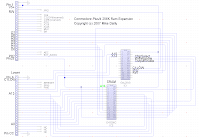The MMC64 can load 61k in 3 seconds....damn thats fast! I think they allow proper access to it rather than SPI mode where the CPU "clocks" the bits in. I can probably speed that up by putting a PIC on there and having BYTE access to the card. But thats a LOT of work.
If I put a byte Read/Write port in there, then got the PIC to do the bit talking, then the Plus/4 could just read/write bytes. I guess that would be a x8 speed up (ish), but it might be a bugger to do. That would be almost on par with the MMC64 though, and with the higher clockspeed of the Plus4, I might even beat it.
I swapped the DataIn line from bit 3 (0-7) to bit 7, which meant I could use the BIT instruction to read it, there by freeing up the A register. So now I have a macro to read a bit like this...
GETBIT macro
stx port ; Clock pulse
sty port ;
asl ; Shift incoming data to make space for new bit
bit port
bmi !skip ; Bmi is reversed
ora #1
!skip
endm
This is a special ReadSector() call used when reading the actual data (does 4096 BIT reads - 512 bytes), the write is longer and far slower, but doesn't get used nearly as much. Before I moved the bit from 3 to 7, I had to LDA, then AND, then deal with memory etc.... but by using BIT I can and the AND from memory without affecting anything else. I suspect this is about as fast as it can go via the user port.






